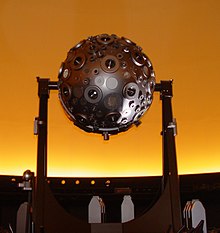Zeiss Planetarium of the City of Vienna
The Zeiss Planetarium of the City of Vienna is one of the most modern planetariums in the world. It is in the same building with the Pratermuseum furnished and located in Vienna Prater . The planetarium is directed solely in the spirit and spirit of Werner Gruber , without any commission from the Vienna city administration . The planetarium, together with the Kuffner observatory and Urania (Vienna), is a specialized facility of the Vienna Adult Education Centers .
Planetariums in Vienna
1927 to 1928
The first planetarium in Vienna was also the first one to be built outside of Germany and existed between May 7, 1927 and September 1928. It was built on today's Maria-Theresien-Platz between the Museum of Natural History and the Museum of Art History . The reason for this was the exhibition “ Vienna and the Viennese ” held in the Messepalast in 1927.
The octagonal pyramid-shaped structure with a round interior of 20 meters in diameter was a simple wooden construction and was designed by the architect Robert Oerley . The hemispherical dome was made of white linen.
1930 to 1945
On January 8, 1930, the planetarium on Praterstern was reopened, where it existed until mid-March 1945. During the Battle of Vienna , the wooden structure and the adjacent Wurstelprater were destroyed.
As before on Maria-Theresien-Platz, a Zeiss model II projector served as a star projector . However, this had to give way to cinema screenings more and more often by being pushed out of the domed hall. From April 1933, there were hardly any star shows.
The director of the first two planetariums in Vienna was Oswald Thomas . The forecourt of today's planetarium was named after him.
1964 until today
The newly built planetarium in the Kaisergarten at Oswald-Thomas-Platz 1 between Riesenrad and Hauptallee was opened on June 20, 1964 (the foundation stone was laid on June 16, 1962). The first director was Hermann Mucke , who held this position until his retirement in 2000. Afterwards the astronomer and technical physicist Peter Habison headed the astronomical facilities of the city of Vienna.
On February 10, 1990, the planetarium was closed due to the risk of asbestos and after the renovation it went back into operation on November 9, 1992. In April 2001 the planetarium was closed again for renovation and reopened on November 8, 2002. The latest technologies such as a Zeiss Universarium M IX star projector , a Zulip laser projector and 24 modern slide projectors were installed. A reinforced concrete dome shell with an outer diameter of 23.5 meters was placed on a three-meter-high, circular surrounding masonry on an area of 1,253 square meters. The projection room has an inside diameter of 20 meters and offers space for around 240 seats.
In addition, a cinema and lecture hall with 125.4 square meters and space for around 180 people as well as space for the Pratermuseum was built, which is accessible through the same entrance.
Since February 2013 the physicist Werner Gruber has been the director of the astronomical educational institution of the Vienna Adult Education Centers.
Since 2014, the planetarium has been coordinating the “Science” project of the Vienna Adult Education Centers under the direction of Werner Gruber, which is an extension and continuation of “University meets Public”, which was initiated in 1998 by the University of Vienna and the Vienna Adult Education Centers. The Science Program provides the Viennese population with up-to-date and socio-politically relevant knowledge and offers a varied and interdisciplinary lecture program that illuminates many aspects of the research landscape in Austria. Renowned and aspiring young scientists from the University of Vienna and many other research and educational institutions in Austria vividly present current scientific findings and show the latest research results, state of the art and current studies. An additional offer is the VHS science card, which offers access to all science lectures for one semester.
The science program offers around 200 lectures and events per semester and has over 10,000 visitors a year.
In February 2018, the City of Vienna's planetarium received 8 Zeiss Velvet projectors. This replaced the Zulip laser projector and with the new system moving projections can be shown in the entire dome. The Universarium M IX star projector has been preserved and is used in parallel with the Velvet projectors.
Prater Museum
The Pratermuseum is a branch of the Wien Museum and illustrates the history of the Wiener Prater (Wurstelprater and “Grüner Prater”) as an event and recreation area. On display are the Prater collection by Hans Pemmer as well as exhibits from the holdings of the Wien Museum, the Adanos collection and the Laterna magica collection by Ernst Hrabalek.
literature
- Oswald Thomas: " The Vienna Planetarium - An Introduction " Verlag der Wiener Messe, Vienna, 1927
- Stadtbauamtsdirektion (publisher): " The new planetarium in the Vienna Prater "
Web links
Footnotes
- ^ The Vienna Adult Education Centers planetarium-wien.at, accessed on October 19, 2012
- ^ A b c The Wiener Volkshochschulen GmbH: Planetarium Vienna - The Wiener Volkshochschulen. In: vhs.at. May 7, 1927, Retrieved October 7, 2019 .
- ↑ http://www.stadt-wien.at/index.php?id=prater-details
- ↑ Dr. O. Thomas: The Vienna Planetarium
- ^ Website of the Austrian Academy of Sciences
- ↑ Adventure Science m-coach.de
- ^ Wilhelm Petrasch: The Vienna Urania. From the roots of adult education to lifelong learning. Böhlau Verlag, Vienna-Cologne-Weimar 2007, ISBN 978-3-205-77562-1 .
- ↑ The planetarium in the Prater opens again derstandard.at
- ↑ Das Wiener Planetarium , No. 45 of the series Die Stadt Wien provides information , October 1964
- ↑ wien.gv.at: Werner Gruber takes over management of the astronomical facilities at the VHS Vienna , October 18, 2012
- ↑ planetarium-wien.at: Staff members of the Vienna Planetarium, Kuffner & Urania Observatory
- ↑ State-of-the-art technology in the Vienna planetarium - wien.ORF.at. Retrieved March 20, 2018 .
Coordinates: 48 ° 12 ′ 57.5 ″ N , 16 ° 23 ′ 40.5 ″ E



